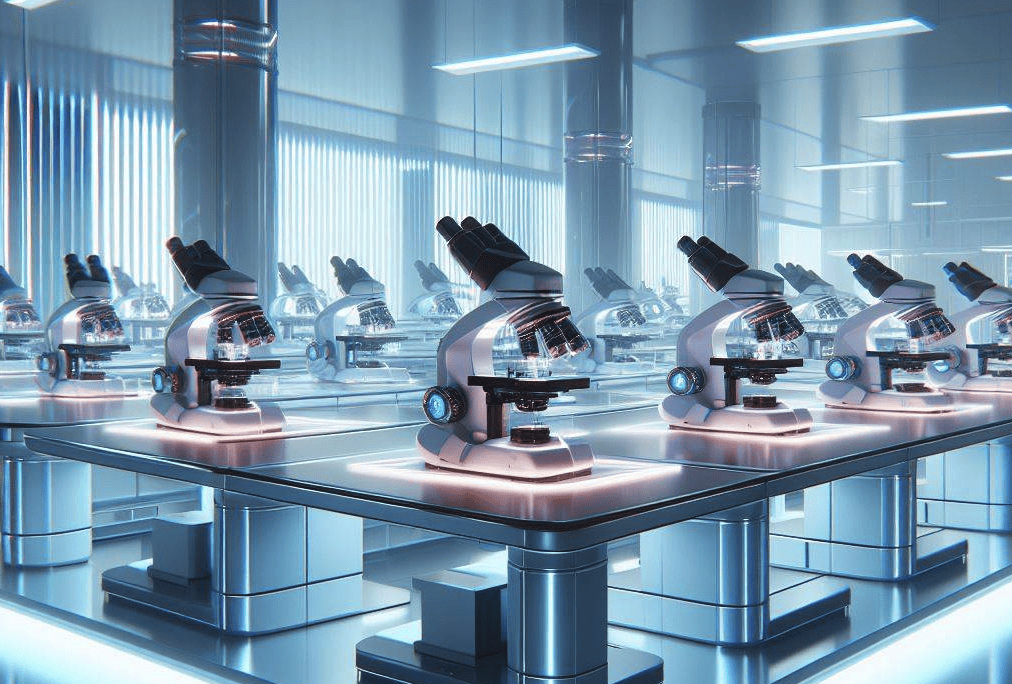
For those unfamiliar with what a microscope is and how it works, a microscope is an instrument that produces enlarged images of small objects, allowing you to see minuscule structures that are normally invisible to the naked eye.
Optical microscopes, the most familiar type, use visible light focused through lenses to magnify the image.
They can magnify up to 2,000 times and resolve details to about 0.2 micrometers.
They can be simple, with a single lens, or compound, with multiple optical components.
Apart from optical microscopes, there are different types of microscopes including electron microscopes that use beams of electrons, and others that utilize lasers, sound, or X-rays.
Some microscopes offer various imaging possibilities, including photography and digital imaging.
Understanding How Does Microscope Work
To understand how a microscope works, it’s important to grasp its basic mechanism and the role of optics in magnifying tiny objects.
A microscope operates using a combination of lenses and light to produce enlarged images – by manipulating the properties of light, microscopes enable us to see details that are otherwise invisible to the naked eye.
The basic working principle of a microscope involves the passage of light through the specimen being observed.
This light interacts with the object, causing it to bend and scatter. As a result, the image of the object is magnified and projected towards the viewer’s eye.
Working together to focus and enlarge the image, the microscope lenses play a key role in this process.
The optical components of a microscope include an objective lens and an eyepiece lens.
The objective lens is positioned close to the specimen and collects the light that interacts with it.
It then forms an enlarged and inverted real image within the microscope.
The eyepiece lens at the top of the microscope further magnifies this image and allows the observer to view it comfortably.
By adjusting the focus knobs on the microscope, the observer can bring different parts of the specimen into sharp focus.
This manipulation of the lenses allows for a clearer and more detailed view of the specimen.
In addition to focusing, microscopes often have adjustable illumination sources to enhance the visibility of the specimen.
Understanding the mechanism of a microscope, including its optics and basic workings, provides a foundation for exploring the fascinating world of microscopic structures.
A Closer Look at Optical Microscopes
 Optical microscopes, the most common type of microscope, utilize visible light and a series of lenses to produce magnified images.
Optical microscopes, the most common type of microscope, utilize visible light and a series of lenses to produce magnified images.
These microscopes consist of several essential components that work together to enhance the resolution and clarity of the observed specimen.
By understanding the mechanism behind optical microscopes, we can operate them effectively and obtain accurate results.
Components of an Optical Microscope
An optical microscope typically consists of an objective lens, an eyepiece or ocular lens, a stage, and a light source.
The objective lens is responsible for capturing and magnifying the image of the specimen, while the eyepiece further enlarges the image for the observer.
The stage holds the specimen in place, allowing for precise positioning and examination.
The light source (a lamp or a mirror), illuminates the specimen, making it visible under the microscope.
Additionally, optical microscopes often feature adjustable focus knobs and condenser lenses. The focus knobs allow for fine-tuning the focus of the image, ensuring optimal clarity.
Condenser lenses, on the other hand, control the amount and direction of light that reaches the specimen, enhancing image contrast and brightness.
Magnification and Resolution
Microscopes can magnify objects through several magnification levels hence they resolve tiny details with high clarity.
Optical microscopes can magnify up to 2,000 times, allowing researchers to study specimens in great detail.
The imaging capabilities of microscopes extend beyond visual observation.
Microscope photography allows researchers to capture images of specimens for documentation and analysis.
Digital imaging techniques further enhance the ability to record and manipulate microscopic images, facilitating data sharing and processing.
These imaging possibilities contribute to scientific advancements and foster a deeper understanding of the microscopic world.
Applications of Microscopes
 Microscopes find applications in numerous fields, where they are instrumental in conducting detailed investigations, analysis, and research.
Microscopes find applications in numerous fields, where they are instrumental in conducting detailed investigations, analysis, and research.
Let’s explore some of the practical uses of microscopes in various disciplines:
Biology
In biology, microscopes are indispensable tools for studying the intricate structures of biological specimens.
They enable scientists to examine cells, tissues, and microorganisms, unraveling their functions and interactions.
In Genetics, microscopes facilitate the observation and manipulation of DNA molecules. They also aid in genetic research and the development of gene therapies.
In the study of embryology, microscopes help scientists understand the early stages of development in organisms.
Medicine & Surgical Procedures
In medicine, microscopes are essential for diagnosing diseases and conducting research.
Pathologists use microscopes to analyze tissue samples and identify abnormalities, such as cancerous cells.
In microbiology, microscopes facilitate identifying and characterizing bacteria, viruses, and other pathogens.
Furthermore, microscopes are utilized in surgical procedures, enabling surgeons to perform delicate operations, especially in specialties such as ophthalmology and neurosurgery.
Materials Science
Microscopes are invaluable tools in materials science, aiding in the exploration and analysis of various materials and their properties.
Scientists use microscopes to study atomic and molecular structures of materials, investigating their composition, crystallinity, and surface characteristics.
This information is vital for the development of new materials with enhanced properties, such as lightweight alloys, advanced ceramics, and high-performance polymers.
From biology and medicine to materials science and forensics, microscopes find applications in various fields.
They have played a crucial role in advancing our understanding of the natural world and have paved the way for countless scientific breakthroughs.
As technology continues to evolve, so do microscopes, with ongoing advancements enhancing their imaging capabilities and pushing the boundaries of scientific exploration.


